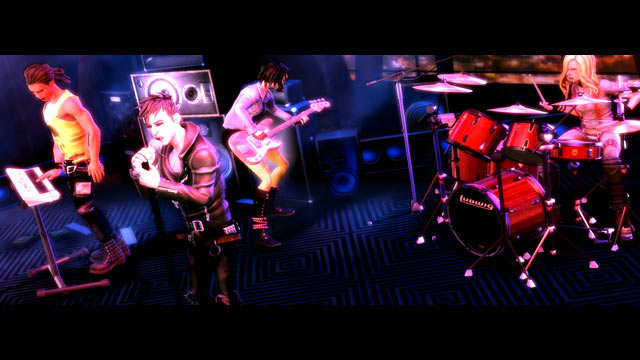
The rhythm game genre has been one giant roller coaster ride over the last five years, with major ups being provided by a slew of excellent, trailblazing titles, numerous twists thrown in by innovative ideas and comically bad, half baked imitators, and more than a few steep falls thanks to the recent string of disappointing releases. Throughout this ride only one company has been directly responsible for the bulk of the ups while also weathering so many of the downs. When it comes to music games, Harmonix is the undisputed king, and Rock Band is its rightful claim to the throne.
Right from the start, Harmonix has focused entirely on music, with the release of Frequency in 2001 and Amplitude in 2003. Neither of these inspired rhythm games achieved major commercial success, but critics were impressed, as were enough gamers to gain the titles enough success to keep Harmonix in business. From 2003 through 2005, Harmonix kept busy with Karaoke Revolution and several of its sequels, while starting to put together the game that would make it famous. Working together with RedOctane, a company that produced the dance pads for DDR at the time, Harmonix began work on Guitar Hero and the famous guitar-shaped controller that was the catalyst for a flood of fake plastic instruments that would fill the basements of countless gamers.
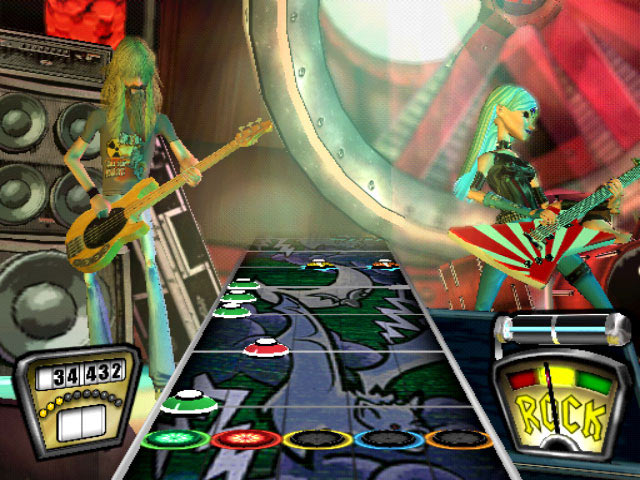
Getting nostalgic for 2005?
Upon its release on PS2 in 2005, Guitar Hero was a massive success, an especially noteworthy and surprising outcome given the higher price demanded by the packed in peripheral. With millions of gamers living out their rock and roll dreams in front of their TVs, producing a sequel was a given. A year later, Guitar Hero II was released with a bigger, better set list and co-op multiplayer, so it came as no surprise that it too was a major hit. It was at this point that it became quite obvious that Guitar Hero was now a major franchise and Activision wanted in on the action. Seeing how RedOctane owned the franchise rights, Activision acquired the company for nearly $100 million, thus leaving Harmonix out in the cold, unable to continue work on the series that made it famous.
Luckily, such talent rarely goes overlooked for long, and, in a rare move that was actually music-related, MTV bought Harmonix. With MTV’s considerable financial resources and music industry connections, Harmonix set to work on its ultimate dream, using the foundation started in Guitar Hero to create a full band, rhythm game experience. In 2007, Rock Band was unleashed upon the world, thus starting a heated rivalry with Guitar Hero that would bring music games to the forefront of the gaming universe.
Three years has passed since then and much has changed. Rock Band and Guitar Hero remain the biggest names in the genre, but the music game craze that drove both franchises to such popularity has greatly subsided. However, Rock Band has taken the blow much better than Guitar Hero, and the reason for that is simple: Rock Band has always been the better game and more complete rock and roll experience. Many factors contribute to this fact, ranging from choice of music to the franchise’s consistent aesthetic vision.
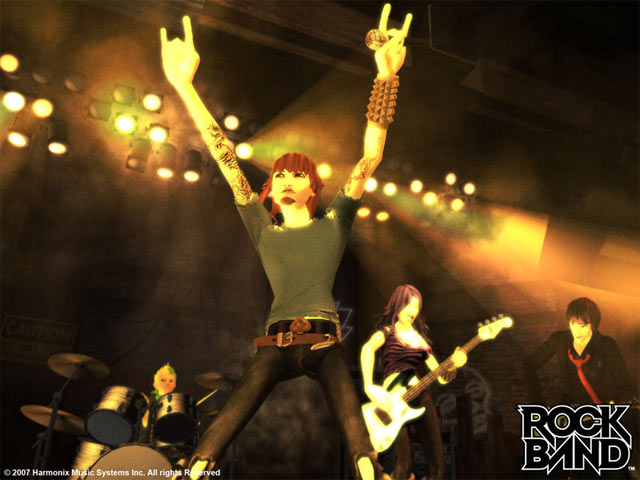
Do you think he uses Old Spice?
When it comes to building setlists, Harmonix is second to none. Each game in the series features a setlist that is well balanced but still retains a unique enough identity to make each title noteworthy in its own right. Rock Band acted as a great introduction due to the universal appeal of its setlist, which featured equal parts contemporary hits and classic rock while also providing numerous standout songs for each instrument. Rock Band 2 once again featured a varied setlist, but Harmonix took an extra step to give players extra challenges by featuring a heavier emphasis on metal and hard rock with the likes of Testament, Dream Theater, and Judas Priest occupying the back end of the game. Though we have yet to experience its entire setlist first hand, Rock Band 3 looks like it will soften up the intensity a bit by including an eclectic mix of artists and genres meant to highlight the addition of keyboards.
Of course one can’t talk about music selection without bringing up the freedom Harmonix has given gamers in creating their own setlists. Starting with the release of Rock Band, at least with the Xbox 360 and PS3 versions, Harmonix has delivered on its promise to deliver weekly batches of new content. This content strategy has allowed Harmonix to provide something for everybody; one week could offer a seemingly random collection of songs from varied artists, the next could be a major album from on of rock’s greatest acts, and then that could be followed with a smaller batch of genre- or artist-specific content. Furthermore, Harmonix launched the Rock Band Network earlier this year, a service by which artists can self-publish their songs in the game. Though this service is only running in full force on Xbox 360, where it delivers new songs daily, Wii and PS3 owners receive some of the offerings in “best of” collections. Altogether, the series offers over 2000 tracks, a number that none of its competitors even come close to matching.
Though it may strange to bring this up while talking about music games, Rock Band has also benefited from consistently excellent art direction. Throughout each game, whether you are playing a song or navigating through menus, you are constantly exposed to an aesthetic experience ripped straight from an idealized world of rock fashion, tattoos, and album art. It also helps that the character creator allows for stylized designs that are just exaggerated enough to allow for some crazy creations without looking overly gaudy or awkward, unless of course that is what you are going for by adding in ridiculous clothes, face paint, and piercings. The venues and performances have also been portrayed well in every entry so far, with the original two offerings creating shows that could have been taken from a concert. The spin-offs have also delivered big time in this regard: Rock Band Beatles received major acclaim for the dreamscape sequences that served as back drops for the Fab Four’s Abbey Road sessions, and Lego Rock Band took advantage of the toy license to have a great deal of fun with performances, including setting the Ghost Busters theme to a rock and roll exorcism of a haunted house, and recreating legendary rock group Queen with the titular bricks.
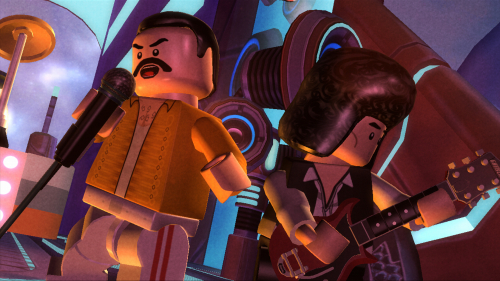
“Weeeeee… are the (LEGO)Champions!”
Ultimately, the single most important factor responsible for Rock Band’s success is innovation. With Guitar Hero, Harmonix created a whole new way to play rhythm games, and with Rock Band the developer didn’t just drastically improve and expand upon that idea, it also created a brand new platform through which music could be distributed and experienced. These two variables, the enjoyable gameplay and innovative Rock Band Store, worked in tandem to help build a dedicated community of music and game fans. To these people, Rock Band transcended mere music and gaming to become an entity in and of itself, a whole greater than the sum of its parts.
Rock Band 3 represents the next major innovation to come out of Harmonix thanks to the addition of Pro Mode, a note-for-note translation of each instrument’s actual parts. For critics of the series who have argued it is better to just pick up a real instrument, Pro Mode is the solution. Putting this together had to be quite a challenge for Harmonix, as Pro Mode forced the developer to think of new ways to notate songs that accurately and legibly portrayed two octaves worth of a keyboard and all six strings of a guitar, including fret positions and chords. The other major challenge was putting together guitar controllers that could read and communicate all the necessary information to the game, and one of the solutions is an actual six string guitar modified to do just that. Now it is just a matter of time to see how effective Pro Mode actually is at teaching gamers to play real instruments.
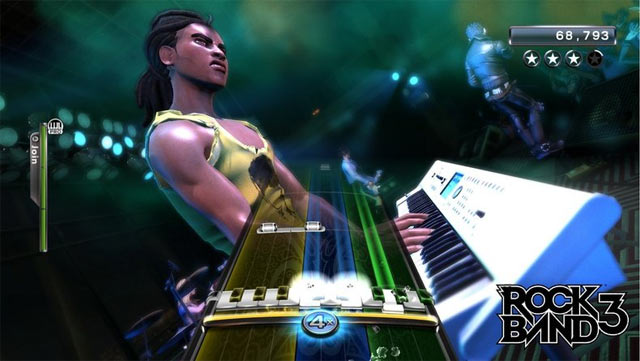
Obviously a screenshot from the 360 version.
Also, on a side note, it’s hard to talk about why Rock Band is so successful without talking about what Guitar Hero has done so wrong to fall so far. Activision’s first mistake with the once impressive brand was trying to beat Rock Band at its own game. Among serious fake guitar shredders, Guitar Hero III was the pinnacle of the series. Keeping the game limited to guitar allowed the developers to make a more focused product with probably the most enjoyable and challenging setlist to ever grace the series.
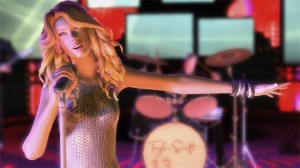 |
| Not featured in a Rock Band game: Taylor Swift. (She was in Band Hero.) |
Yet once the series started to focus on full band gameplay in Guitar Hero: World Tour, the attempts to please every instrument ultimately detracted from the experience and it became clear that Neversoft, the new studio behind the series, simply wasn’t as good as Harmonix at note charting. The next major problem was Activision’s attempt to milk the series by releasing an ever-increasing number of sequels and spin-offs each year. Band centric releases like Guitar Hero: Metallica and Van Halen, DS releases with the uncomfortable Guitar Grip peripheral, spin-offs like DJ Hero and Band Hero, along with Guitar Hero 5, pushed the number of titles to over half a dozen in 2009 alone. These factors haven’t necessarily made these games bad, but they have overwhelmed gamers with quantity, while underwhelming them with the actual experience. Plus, the growing pile of instruments in many a gamer’s home didn’t help much either.
2010’s Guitar Hero: Warriors of Rock has already tested the waters of this year’s music game demand and the results aren’t all that promising. The game moved about 100,000 upon its release, a decent showing but one that pales in comparison to what the brand could accomplish a few years ago. Given this, it will be interesting to see how gamers react to Rock Band 3, which definitely carries on the franchise’s penchant for innovation and vision for creating top notch music and gaming experiences, but whether or not the average consumer will be excited remains to be seen. While the gaming press and plenty of serious gamers are looking forward to the game, more casual gamers have historically made up a significant portion of the music game market and their reactions are always the most difficult to predict. Regardless how the rest of the world embraces Rock Band 3, I know I can’t wait to boot up Pro Mode and start working on Chris Squire’s amazing bass line in “Roundabout”.
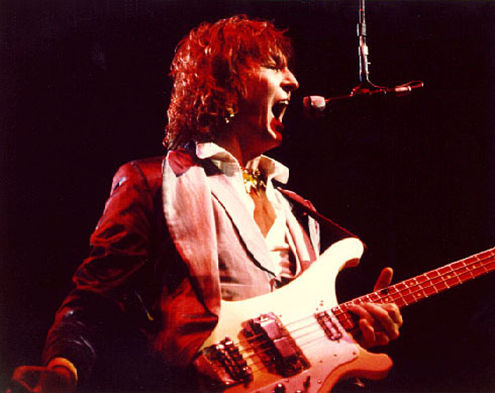
“Hello! I’m Chris Squire, and I’m better than pretty much everybody!”




 ShareThis
ShareThis







Good article. “Lego Rock Band” is one of the more entertaining music games I’ve played, largely due to it being Lego-themed– the Ghostbusters piece you mentioned is what stands out. Well, that, and how octopi can’t be drummers.
I also have to agree with the pile of plastic. Here’s my count: 4 guitars, 4 bongos, 1 set of drums, 2 turntables, 1 microphone, and 0 musical talent.
No set list will ever beat Guitar Hero 3’s. It was solid right the way down with really awesome songs.